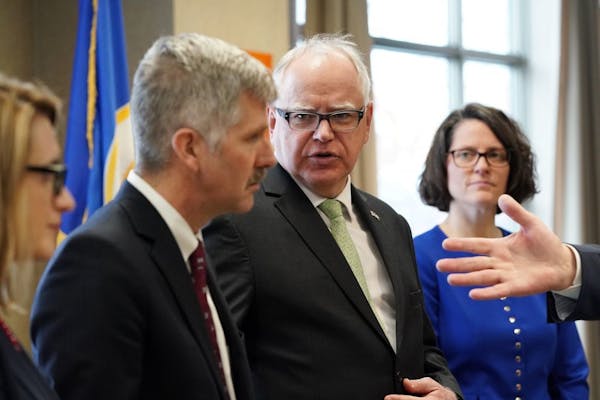Operating income for Minnesota's nonprofit health insurers more than doubled last year as health plans made more money than expected in the market where individuals buy coverage — and could be issuing $37 million in rebates, as a result.
The financial data released Monday show the continued recovery of the individual market, which provides coverage for a small share of all Minnesotans but has had an outsized impact on insurance company finances since changes with the federal Affordable Care Act (ACA).
The market generated red ink for Minnesota's nonprofit health plans in 2014 through 2016, and consumers were hit with huge premium increases as a result. But the market in 2017 became profitable and generated so much operating income last year that two carriers expect to pay rebates to consumers as required by the ACA.
"When medical bills aren't as high as a company expected, the people get rebates," Patsy Riley, interim president of the Minnesota Council of Health Plans, said in a statement. "This part of the law ensures the money people pay for premiums goes for care."
Minnesota's individual market has recovered in part due to a state-funded "reinsurance" program, which covers a portion of the cost for people with unusually large medical bills. The Legislature is currently debating whether to renew the program, which Republicans have backed as a way to maintain stable premiums for the roughly 160,000 people who buy coverage in the market.
"Today's report shows that reinsurance worked," Sen. Gary Dahms, R-Redwood Falls, said in a statement. "It suggests we should expect another reduction in premiums — which are already the lowest in the nation — for next year after the required rate review."
But Sen. Jeff Hayden, D-Minneapolis, said the report shows how state spending on reinsurance is going straight into the pockets of insurers.
"Republicans here at the Capitol seem to be bending over backward to help out health insurance companies who say they're losing too much money to provide affordable coverage," Hayden said in a statement. "Well, now it's clear they're doing just fine."
The Minnesota Council of Health Plans is the trade group for the state's seven nonprofit insurance companies. The group's annual financial release includes figures for Blue Cross and Blue Shield of Minnesota; HealthPartners; Hennepin Health; Medica; PreferredOne; Sanford Health Plan; and UCare.
Nonprofit health insurers don't typically describe their income as profit. When they make money, nonprofit health plans invest the earnings in operations or hold the money in reserve, rather than paying shareholders.
For 2018, those insurers posted operating income of $500 million on $31 billion in premiums, which includes the sums that insurers manage as third-party administrators for "self-insured" employer plans. During the previous year, the nonprofit insurers saw operating income of $227.8 million on $27.6 billion in premium revenue.
The figures don't include investment income, which added about $80 million in 2017 and $90 million last year.
Operating income as a percent of revenue came in at 1.6 percent during 2018, which was one of the best showings in the past decade for the health plans, according to figures from the council.
The federal Affordable Care Act brought sweeping changes to the individual market, which primarily provides coverage for self-employed people under age 65 plus those who don't get coverage for an employer. The ACA brought tax credits to subsidize coverage costs for many in the market. It also required insurers to cover people with pre-existing health conditions.
With all the changes, insurers initially guessed wrong in setting premiums that were too low for medical costs in the individual market. In 2018, rates were set too high, giving insurers operating income in the market of $197 million. Over the past five years, however, the council says insurers in Minnesota's individual market have lost $395 million.
A Star Tribune review of regulatory filings Monday shows that Eagan-based Blue Cross currently projects issuing $33.7 million in rebates to individual market customers. Minneapolis-based UCare projects issuing $3.5 million rebates. Final amounts won't be determined until this summer.
The ACA requires health insurers to pay rebates if they fail to spend specified percentages of premium revenue on medical care and quality improvement programs. The rule effectively caps the share of premium revenue that an insurer can keep for administration and profit.
While the profitability of the individual market in Minnesota contributed to the overall results for insurers, it wasn't the only factor. The health plans serve as managed care organizations for Minnesota's public health insurance programs, and profitability swung considerably — from a collective loss of $79 million in 2017 to a gain of $109 million in 2018.
For decades, the public program market was reserved for Minnesota's nonprofit HMOs. Lawmakers in 2017 eliminated the ban on for-profit HMOs, however, and Minnetonka-based UnitedHealthcare earlier this year became the first for-profit company in the state to get an HMO license.
The trade group's financial report tallies operating income from the insurance companies' business outside Minnesota. Minnetonka-based Medica saw a significant rebound in its business selling coverage to individuals in Iowa and Nebraska — two states that saw all other carriers flee the market.
That left Medica in 2018 as the only health plan selling through the ACA's health exchange marketplace in those states. Membership across Iowa and Nebraska jumped from 43,000 people to about 135,000 people, said Geoff Bartsh, a Medica vice president.
"It was risky," Bartsh said "Not only were we looking at a huge growth in membership, but [it came] in two states where we didn't have a lot of history."
Christopher Snowbeck • 612-673-4744 Twitter: @chrissnowbeck
Closing prices for crude oil, gold and other commodities
Baltimore port to open deeper channel, enabling some cargo ships to pass after bridge collapse
Phish fans are famously dedicated. What happens when they enter the Sphere?
The head of Mexico's detective service says his country is the 'champion' of fentanyl production

